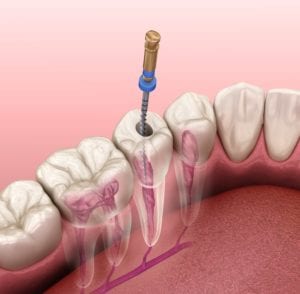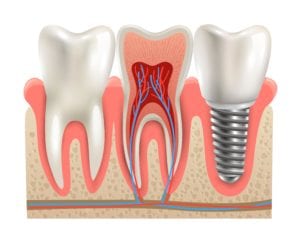Root Canals vs. Dental Implants: Which is Best?

Pulp infections occur when bacteria has entered the innermost layer of the tooth. Since dental pulp is composed of blood vessels and nerves, it can become inflamed and cause a sudden, deep tooth pain. Unfortunately, the only treatment for a pulp infection is to remove all the infected tissue. Traditionally, this has been accomplished through a root canal, however root canals are no longer the only option. A tooth that has been significantly affected by damage or decay to the point of infection can instead be removed and replaced with a dental implant. Here are how these two options compare:
Root Canal
A root canal is a restorative procedure in which your dentist will drill a small hole in your tooth to reach the pulp chamber. Once inside the chamber, a series of root canal files will be used to remove all of the decayed tissue, as well as the tooth’s nerve. The empty chamber will then be cleaned to prevent further infection before it is filled with a rubber-like material called gutta percha. In some cases, a small post may also be inserted into the tooth for additional support. The access hole will be filled with composite resin to seal the inside of the tooth. The final step is to restore the tooth by using a dental crown.
Root canals offer the following benefits:

- They preserve the natural tooth structure
- The entire process generally takes about 2-3 dental visits
- They are more affordable than dental implants
- Minimal recovery time with little to no pain
However, they also have the following downsides:
- A severely decayed tooth may be too far gone for a root canal
- Abscesses can occur when all the infected pulp is not removed
- Root canal retreatment or apicoectomy may be required if root canal fails
- Severely damaged or decayed teeth are more likely to fracture during a root canal
Dental Implants
Dental implants are artificial tooth roots that can support a dental crown. They are used when the infected tooth is extracted and a tooth replacement option is necessary. To place a dental implant, a minor oral surgery is needed since they are placed in the jawbone. Overtime, the surrounding bone will fuse with the implant and secure it in place. An implant-supported crown will then be cemented to the connector piece above the gums. The final result is a fully-functional and aesthetically pleasing tooth replacement.
Dental Implants offer the following benefits:

- Eliminate the chances of a second infection and consequent procedures
- Offer the look and function of a real tooth without the risk of infection
- Have a high success rate
- Results last longer than those of a root canal
However, they also have the following downsides:
- Requires minor oral surgery
- Recovery takes longer than that of a root canal
- Generally costs more than a root canal
As you can see, both root canals and dental implants can be used as methods to treat a severely damaged or decayed tooth affected by a pulp infection. At a glance, root canals preserve the natural tooth, but are more likely to require secondary treatment, while dental implants require tooth extraction, but provide a replacement option that is functional and long-lasting. Ultimately, to decide which treatment is right for you, you will need to discuss your individual case with your dentist.






Recent Comments